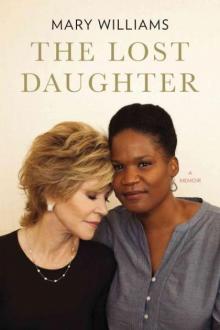- Home
- Mary Williams
The Lost Daughter: A Memoir Page 13
The Lost Daughter: A Memoir Read online
Page 13
Some weekends Laila and I’d go to dinner parties instead of out dancing. At these parties I enjoyed listening to the Moroccan dinner guests, all in their early to late twenties, engaging in very enlightened conversations about world politics, literature and even religion. Many knew as much if not more about U.S. history, geography, politics and popular culture than me.
I was stunned by the size and grandeur of the homes we visited. When Laila was invited to attend a party thrown in honor of Prince Moulay Rashid, one of King Hassan II’s two heirs to the Moroccan throne, I happily tagged along. I was truly taken aback by what I saw. In the States I’d been in many beautiful homes and was privy to the lifestyle of some of our country’s wealthiest, but I’d never been in a home where it would have been practical to have a golf cart on hand to get from one end of the house to the other. At least three of Ted’s beloved Avalon could have fit into some of these homes, which in reality were more along the lines of palaces.
The first thing my eyes were drawn to upon entering the formal salon was how, despite the size of the room, it was cozy and inviting. Sultry lighting poured from Moorish globed, brass lanterns suspended from the ceilings and strategically placed candles in elaborate holders casting the room in shades of amber. Several areas contained upholstered banquette seating in rich fabrics and covered in embroidered, tasseled pillows in deep shades of red and blue. Each seating area had its own wide, low, polygonal dining table inlaid with geometric patterns.
There were columns partially covered in traditional terracotta tiles known as zellige decorated with Arabic calligraphy, which Laila told me were quotes from the Quran. The walls were covered in tadelakt, an ancient plastering technique, which made the walls reflect light and appear to glow. But the most beautiful aspect of the room was the carpets. Beautifully crafted antique Berber carpets. I’m not talking about the modern, mass-produced Berber wall-to-wall carpet sold in the West. I’m talking brightly colored, intricately designed museum pieces woven by real Berber tribesmen. Carpets that were made within spitting distance of camels and sand dunes, not in some factory in China.
The wailing and crashing cymbals of traditional Gnawa, malhun and chaabi music could be clearly appreciated beneath the susurrations of conversation. There were about forty guests, the sons and daughters of the country’s elite. I was the only foreigner. Soon after arriving, Laila introduced me to the prince. He was tall, athletic and baby-faced, just two years younger than me. He graciously welcomed me but struggled to make small talk. He held my hand and stroked it like a cat while smiling at me through unfocused eyes. This went on for nearly thirty seconds until another woman approached eager to greet him. I extricated my hand and stepped aside. And as with me, he began stroking her hand and staring into the near distance with a pleasant smile on his face. The fact that the prince was just your average, socially awkward twenty-something somehow put me at ease.
Later, I briefly found myself the life of the party. My fledgling Arabic was attracting a lot of attention from the other guests because it was quite rare for foreigners to speak the language. I was told an American accent in Arabic is quite pleasant, much like a French accent in English. After being seated at our table and before the meal began, I was asked to speak more Arabic. “Tell us your name and a little about yourself!” a guest asked, and everyone leaned in toward me with expectant faces. When I said it, they all laughed and clapped as if I’d just told a hysterical joke. I was prompted to say a few more things, which elicited a similar delighted response from the guests. Some patted Laila on the back, congratulating her for bringing along the night’s entertainment.
I was saved by several servants who began to bring in huge platters of food. The meal began with copious amounts of bread being placed on the table along with several salads, my favorite of which was made of cooked eggplant and tomatoes and called zaalouk. Next were several varieties of stews prepared in traditional crockery known as tagines: slow-cooked stews of lamb and chicken with olives, dried fruit, nuts and fresh lemons. This was followed by several types of couscous. Among them was couscous with raisins and onions and couscous topped with chicken, peas, carrots and zucchini. The highlight of the meal was a seafood pastille, a flaky pastry stuffed with white fish, squid, shrimp and vermicelli. There were no utensils or plates. Bread was used to sweep up the food and we all ate from the large serving dishes placed in the middle of the table. Moroccan sweet mint tea, fresh fruit and several varieties of sticky, sweet pastries sprinkled with sesame seeds ended the meal.
After dinner we had refreshments by a large heated pool in the back garden, fragrant with the scent of orange blossoms. There was a bar with lots of wine and hard liquor. Just when the crowd started to get a little out of control—the prince was pushing fully clothed guests into the pool and others were pairing up for romantic interludes in secluded parts of the garden—Laila and I called it a night and headed out. Laila’s friend who invited us to the party instructed his driver to return us to her apartment in the city center. We climbed into the car and leaned back into the soft leather seats and recounted the interesting moments of the evening, but as we pulled out of the gated compound the rose-colored glasses I’d been wearing all evening began to slip.
I noticed that interspersed between the walled compounds of Morocco’s wealthy were the corrugated-roofed shacks of the poor, one-roomed hovels without running water or electricity. There were people sitting with small children bundled in their arms in the glow of campfires used to prepare their food and keep themselves warm. Unlike in the States, where the poor live out of sight of the rich, in Morocco they live side by side. Islam dictates that the poor not be forgotten. One of the pillars of Islam is for every Muslim to have concern for and to give to the needy. Though this was not always practiced, it did create a culture in which the wealthy and poor were able to live closely. I liked this aspect of Moroccan culture.
I’ve tried to never forget my impoverished roots but somehow during my semester in Morocco I’d found myself caught up in the party scene and running around with a group of spoiled rich kids. I assumed the family stay would be with an average Moroccan family, meaning more traditional and with no connections to the royal family. Those folks living in squalor just outside the walls of the fabulously wealthy made me realize I’d actually lost sight of the reason I’d come to Morocco in the first place. Seeing those families huddled in the glow of campfires watching me as I slid by in a chauffeured car was the wake-up call I needed. With just a few weeks left in Morocco, I decided I’d return and do something more than just club hop and go to dinner parties.
I was not done with Morocco. I had family there now. I had to return to the States to finish my degree, but during my tearful good-bye to Laila and Rachida at the airport, I promised them both that I would return—I just didn’t know when or how.
• • •
My final semester of college after Morocco passed quickly. Unlike many of my friends, I was excited to leave school behind and begin my life as a bona fide adult. The weeks leading up to graduation were especially sweet because I’d already scored myself a position as a program counselor at a homeless shelter in Santa Monica. I’d been a full-time summer volunteer at the Ocean Park Community Center for several years, so when a position became available, the director basically handed me the job.
The shelter was a fifteen-bed facility that catered specifically to mentally ill homeless women. It was just a few blocks from our family home near the Santa Monica Pier and not very far from my new apartment. Jane was very proud that I’d found work so quickly. It was important to me to show her I could be self-sufficient.
My job entailed distributing medications, preparing evening meals, scheduling doctors’ appointments, helping our clients apply for or maintain Supplemental Security Income (SSI), among other things. I also worked overnight shifts several days a week from seven P.M. to seven A.M.
The shelter was always full, as clients were allowed to stay a maximum of six months, supposedly p
lenty of time to stabilize on meds and find a job and housing. We saw many battered women and women struggling with addiction. Because the OPCC catered to mentally ill women, one of only a few places in the city, our clients felt safe and understood. The facility was located in a renovated warehouse with high ceilings and skylights. It was bright and open, with private rooms and meals often donated by some of the area’s finest restaurants.
The women only had to refrain from using drugs and alcohol in the facility, take their meds, and seek employment and permanent low-income housing opportunities we scrounged up through partnerships with sister agencies.
I enjoyed the work and getting to know the women. There was one woman in particular, Delores, a thirty-something immigrant from Brazil who I found particularly interesting. She was easy to overlook since she spent most of her time tucked away in an armchair in a corner of the living room. She never chatted with the other women or played cards or board games. She even avoided eating dinner at the dining room tables. She preferred to carry her plate to what was often referred to as Delores’s chair in the corner, where she ate her meal in silence.
Delores suffered from depression and most of the clients and counselors gave up trying to draw her out of her shell. But I noticed that Delores often stared at me when she thought I wouldn’t notice. When I asked her about it, I was surprised that she answered me and even more surprised with what she said. She simply told me she stared at me because I looked like her little sister, who she’d left behind in Brazil.
Delores and I did resemble each other, I realized. We could have easily passed for sisters. She asked if I had relatives from Brazil and seemed genuinely disappointed when I told her no. From that moment on she allowed me to sit quietly with her for a few moments each evening and even engaged in small talk when she could. I desperately wanted to know what had brought her so far from home but I knew opening herself up was painful, and whenever I tried to broach the subject she either shut down or changed the subject. During her six-month stay at the shelter, Delores would remain an enigma, but I secretly hoped that my resemblance to her beloved sister and the few quiet moments we shared freed her at least momentarily from the demons that tormented her.
Another client who was as different from Delores as could be was a vibrant, blond beach bunny named Karen. She was just in her mid-twenties and possessed the flawless skin and effervescent personality of a starlet. In fact she’d left her home somewhere in the Midwest to pursue a modeling and acting career in Los Angeles. Soon after arriving she developed a cocaine habit and was later diagnosed with bipolar disorder. Most of the time she was in a manic state, very animated and talkative. She’d often come over to my office and tell me about her day before giving me unsolicited hair, makeup and wardrobe advice.
Despite her larger-than-life personality that could be overbearing at times, she was often the life of the shelter. I worried about her when she left the shelter for the day—that her looks probably attracted the wrong kind of attention. We all suspected she engaged in prostitution to supplement her SSI. I couldn’t help but feel maternal toward the ladies despite the fact that some were old enough to be my mother.
I spent two years at the center and in that time I burned myself out. Though I was attracted to social work, I didn’t have what it takes to stay in such a position long term. My fault was I cared too much, I tried too hard and I expected too much. I saw a piece of my sister Deborah in each of the women who passed through the door. I took it personally when women I helped to secure housing and jobs, after a few months of self-sufficiency, only ended up right back in the shelter.
I decided it was time to move on. I’d kept in contact with Laila during the two years after I left Morocco. I’d even invited her to spend a few weeks with me in Los Angeles. It was her first trip to the U.S., and a big smile and wide eyes did not leave her face for most of the trip. I also learned she was inexplicably attracted to things that terrified her. We took a trip to an amusement park, where she rode a big loopy roller coaster. And though when she got off she was in tears and her legs too wobbly to stand on, she giggled madly and made her way back to the end of the line to experience it all over again. When I had overnight shifts at the shelter, she stayed up late watching true-life crime shows, which scared her so terribly she couldn’t sleep until I came home the following morning. I told her to watch something more cheerful in the evening but she never would.
So when I called Laila to tell her I was planning to move back to Morocco, she was thrilled. I knew I’d have to have a solid plan for supporting myself before I got Jane’s approval, so I started researching job opportunities and found I could probably get a position teaching English. I’d never taught before, so on my days off from the shelter I went down to my local library to see if I could get certified to help teach illiterate adults how to read.
Certification didn’t take long and I spent a few days a month helping a middle-aged woman who worked as a cook at a local high school learn how to read. With a college degree in history and literature, my literacy certification and a few months’ tutoring experience, I applied for a position as an English teacher at the American Language School in Rabat. I was delighted and shocked when I was hired. I turned in my two weeks’ resignation notice to the shelter and informed Jane of my decision to move back to Morocco. She was impressed with my ability to parlay volunteer opportunities into full-time employment and bragged about me to her friends. She gave me her blessings to move to Morocco but made me promise to write often and come home for the holidays and summer break. Then she asked me what I planned to do with my pet bunny, Bugs.
After I had graduated from college, Jane and I developed a fascination with bunnies. Miniature bunnies, to be precise. I don’t know who purchased a bunny first but for a time we were both totally taken with the creatures. When I moved out of the Alta house and got my own place, I bought a little bunny to keep me company and named him Bugs. He was a tiny little ball of cottony gray fur with a white underbelly and ears that hung down along the side of his head like pigtails. Jane got two bunnies of her own, a miniature lop-eared like mine and a tiny white miniature with eyes ringed in black that gave it the appearance of wearing heavy eyeliner.
Jane had a hutch, which I called the bunny condo, custom built out on the patio behind the house, where she’d spend time playing with her bunnies. I chose not to cage my bunny after a little research revealed that bunnies could be trained to use a litter box. So Bugs ran freely throughout my apartment. He greeted me when I came home and even jumped in my lap and nudged my hand with his head to indicate that he was ready to have his ears scratched.
Some weekends Jane and I would go for long bike rides that led us past a bunny rescue sanctuary in Santa Monica. We’d always get off our bikes and stare at the hundreds of bunnies frolicking around on the other side of the fence. Most were ill-conceived Easter presents, unwanted after the novelty wore off and cages needed to be cleaned. People would bring their bunnies in the middle of the night and toss them over the fence. After a time, a group of concerned animal lovers started caring for the bunnies, feeding and playing with them—even raising donations for sterilizations, medical care and home placements. I’d sometimes volunteer at the bunny farm.
When I was getting ready to return to Morocco, I briefly thought of sending Bugs to live with my mom, but couldn’t part with him. In the end, I bought a tiny traveling cage and Bugs made the transatlantic trip to Morocco with me, probably becoming the world’s first intercontinental lop-eared bunny.
Bugs and I arrived safely in Morocco. The airport customs folks peeked into the carrier, chuckled when they saw my tiny bunny and waved me through. We moved in with Laila and Rachida temporarily while Laila helped me find an apartment nearby. Fairly quickly we found a bright, one-bedroom apartment with tiled floors and a large kitchen located a few blocks from their apartment in Place Bourgogne near our favorite nightclub.
On clear days I walked the two miles to school along the busy, vibr
ant sidewalks past street vendors selling roasted nuts, sips of water and cheaply made cleaning supplies. When the weather was foul I took a taxi, which I hated to do for several reasons. The cab drivers in Morocco drive like they are fleeing Satan himself. They weave in and out of traffic, through red lights, and are not averse to using the sidewalk to avoid having to wait in backed-up traffic. It didn’t bolster my sense of security that there were no seatbelts in the taxis. I also hated taking cabs because the drivers almost always demanded more money than I owed simply because I was foreign.
I enjoyed my students but I hated teaching English. Contrary to what I thought, being a college grad and fluent in English doesn’t make one a good English teacher. I was surprised to learn that all the stuff I didn’t know about the language was more than I knew—by a multiple of ten. I knew my nouns, verbs and adjectives. I could speak intelligently about the past, present and future tenses. No problem. But my students were asking me about aspects of English way out in the hinterlands of my understanding. Holy hell! When did English get more than three tenses? Turns out a world existed beyond verbs and nouns. A big world that, for me at the time, seemed as deep and incomprehensible as quantum physics. Tenses like the past perfect, the subjunctive, the pluperfect, the present perfect, the future perfect continuous.
Often I used films to disguise my knowledge gap. While exposing students to film is a good way to get them familiar with hearing the language, I had ulterior motives. I wanted to show a film to eat up time I didn’t want to spend telling my students that I was wrong in assuming that the future perfect progressive is what the children of liberal democrats aspire to be. On my very first movie night I made a huge mistake that could have cost me my job. I chose from the school video library the movie A Clockwork Orange. I read the synopsis and thought a film set in the future would interest my students. I did not bother to preview it. Later that evening I brought snacks for my small group of eight advanced students to enjoy during the screening, popped the cassette into the machine and pushed Play.

 The Lost Daughter: A Memoir
The Lost Daughter: A Memoir How to Be a Perfect Girl
How to Be a Perfect Girl The Velvet Glove
The Velvet Glove Portrait of a Girl
Portrait of a Girl